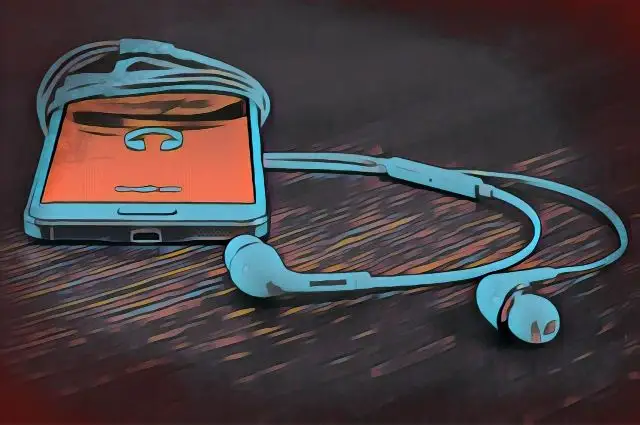Buying music is dead, and streaming platforms like Spotify and Apple Music have become go-to options for listening to music these days. With vast libraries and relatively affordable subscription prices, how can people say no?
On the downside, however, many audiophiles have criticized the low-quality audio offered by these platforms.
When Tidal appeared in 2014, the aim was to address this issue by offering a hi-fi audio experience. Though we're still unsure if Tidal saw the success they were looking for, the industry is now shifting towards lossless streaming, with Apple Music introducing lossless audio and rumors of Spotify following suit.
Even with all the buzz, many people are wondering, what in the world is lossless audio streaming, and why do so many people make such a huge deal about it?
In this guide, we're going to explain what lossless audio is, why it matters, and how you can enjoy it!
What Is Lossless Audio Streaming?
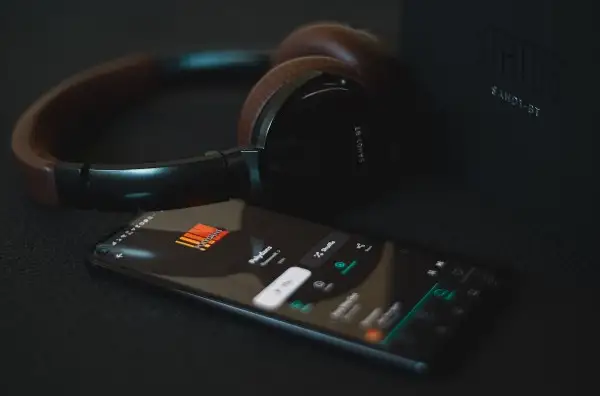
Lossless streaming is a relatively new feature offered by select streaming platforms. It allows users to listen to high-quality audio files without data loss, as you'd find in typical lossy streaming.
Lossless audio files are of the highest resolution, streaming with a high sample rate and bit depth since they haven't been subjected to lossy compression methods.
Some of the most popular Lossy compression methods are MP3 and AAC. These audio storage methods work to reduce the file size by discarding some data that is deemed "insignificant."
Now, this doesn't mean lossy audio doesn't have its place.
It's actually quite suitable when storage space is limited.
However, one of the major arguments against the loss of data is that it adversely affects sound quality.
Additionally, most modern digital recordings output audio with higher sample rates and bit depths than the 16-bit, 44.1 kHz standard of CDs back in the late 1980s.
In a sense, you could say that lossless high-resolution audio is the true way to listen to music. It's the format that allows listeners to hear music as the artist or engineer originally intended.
That doesn't mean lossless audio is all rainbows and unicorns.
One of the main downsides of this hi-res audio format is that it's larger than a standard compressed file format. When you use lossless audio streaming, you have to use greater bandwidth. The good thing is that there are now certain data compression methods that retain 100% of the original data while cutting down the file size.
Now, anyone with a decent Wi-Fi connection can stream lossless audio with ease!
Do I Need Lossless Audio?
Not anyone can just listen to lossless audio, as it's a premium feature that requires a few additional steps if you want the full experience.
Now, you might be wondering, is it worth the extra bandwidth required for streaming?
While there isn't any objective consensus on whether high-resolution audio sounds better, even though audiophiles will swear by it, blind tests suggest that many listeners find it pretty difficult to distinguish the two.
Of course, if you're someone that produces or mixes music for a living and you have a pair of quality studio monitor speakers or excellent headphones, you may actually find that lossless files sound superior.
Ultimately, it's a matter of personal preference.
Although the subjective differences may not be significant, lossless files contain much more relevant audio information, which may be enough to motivate you to give it a try.
You'll have to listen critically to determine if high-res audio is essential to your listening experience.
How Does Lossless Audio Streaming Work?
To make lossless streaming possible, streaming services must use lossless audio codecs .
These codecs compress files without getting rid of any important audio information, preserving the original audio quality of the file while reducing its size for easier storage and streaming.
There are a few common codecs you'll find in lossless streaming:
- FLAC (Free Lossless Audio Codec) - FLAC is one of the most flexible codecs, offering high-quality audio compression. Though you may haven't heard of it if you're not an audiophile, it's supported by a wide range of audio devices and software.
- ALAC (Apple Lossless Audio Codec) - ALAC is Apple's proprietary codec. Similar to FLAC, it offers lossless audio compression, though it is primarily used for Apple Music streaming.
- WAV (Waveform Audio File Format) - WAV probably sounds familiar to most of you, as it's one of the most popular forms of lossless audio compression in professional audio production.
- AIFF (Audio Interchange File Format) - AIFF is similar to WAV in terms of popularity and flexibility, as it's widely used in audio production, mixing, and mastering.
Without these codecs, we wouldn't be able to enjoy lossless music.
How to Listen to Lossless Streaming
Lossless music is encoded in a different audio file format than standard streaming audio. Compared to CD-quality audio, it has a much higher sample rate and bit depth.
This means that if you want to get started with lossless streaming, you'll need a proper combo of lossless-ready hardware and software.
Lossless Streaming Hardware Requirements
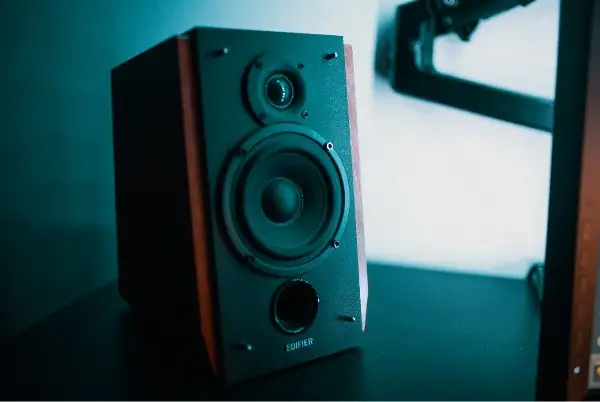
Though it might seem obvious, you'll need some sort of high-quality audio playback device, such as a smartphone or laptop. However, it's important to note that the audio output capabilities of most common consumer electronics are limited.
Luckily, if you have a pair of high-quality professional-grade headphones or speakers that can reproduce high-resolution audio, you're good to go.
Depending on your computer or smartphone, however, you might also need a high-quality audio interface that can support sample rates up to 96 kHz. The good news for music producers, most mid-range audio interfaces can do just that!
However, for the ultimate audiophile experience, you might want to invest in high-end converters.
Lastly, even though lossless streaming services use reduced file sizes, you'll need a fast and stable internet connection with sufficient bandwidth.
If you're streaming lossless music on the go, be aware of the extra data usage. Depending on your streaming settings, even a single minute of audio playback can eat up to around 8 MB of data.
Lossless Streaming Software Requirements
The first thing you'll need to stream lossless music is lossless streaming software that supports popular lossless audio codecs, including the ones that we discussed above (WAV, FLAC, ALAC, etc.). Beyond having the ability to stream the proper codecs, your streaming service should support high-bitrate audio playback. Otherwise, it could compromise your audio quality during transmission.
We'll go over a few examples of lossless music streaming services next.
Note that if you plan on listening to lossless quality audio offline, you'll need adequate storage space on your device to store those lossless audio files.
Best Lossless Streaming Services
In the past, lossless audio was a specialized market. However, as more and more streamers are looking to enhance their music streaming experiences, there are more opportunities to access high-quality audio through the internet.
Let's take a look at a few of the popular lossless music streaming services and what each is known for.
Apple Music
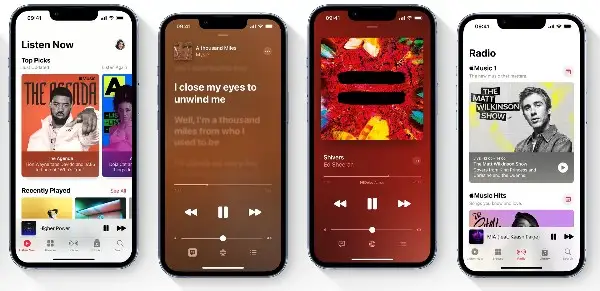
Apple Music introduced lossless-quality audio on its platform a short while back, and it created a serious buzz in the industry. The decision for Apple to shift its focus on providing superior sound quality was a move that takes us back to the early days of iTunes, when MFiT was the digital release standard.
You could say that Apple, compared to most lossless streaming services, is positioning itself for the possibilities of future streaming. Even beyond leaning on the lossless audio format, the company developed an innovative spatial listening option by partnering with Dolby Atmos.
Want to completely immerse yourself in a three-dimensional soundscape and escape the stresses of reality?
Apple has made it possible!
The team at Apple offers two tiers of lossless streaming capabilities, including:
- Lossless: With regular lossless switched on, you get CD-quality audio up to 24-bit/48kHz.
- High-Res Lossless: Taking it a step further, Apple introduced high-res lossless, delivering superior 24-bit/192kHz audio. Essentially, you can listen to your favorite music in what many audiophiles would refer to as "studio quality."
Luckily, you don't need to go out and spend a thousand dollars to enjoy what Apple Music has to offer, as the streaming service is compatible with several Apple devices, including iPhones, iPads, and Macs.
The best part is that you can access this feature at no extra cost and easily toggle between lossless and regular streaming options in your settings.
Tidal
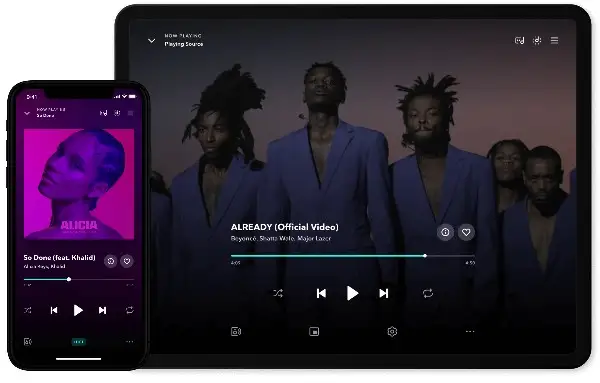
Tidal was the OG in lossless streaming, and to this day, the platform delivers a pretty enticing high-quality streaming option.
You get two options when you subscribe to Tidal's streaming service, including:
- Tidal HiFi: With the standard HiFi tier, you can listen to your favorite music in FLAC format. Compared to your standard ultra-compressed audio, Tidal's HiFi audio sounds super precise and detailed.
- Tidal Masters: If you can't afford to tarnish your audiophile reputation, the Tidal Master tier provides access to legitimate studio-quality audio recordings that have been authenticated and approved by the artists themselves.
- To make it easy to stream without using too much data, the team at Tidal employs MQA (Master Quality Authenticated) technology, which delivers high-resolution audio in a small file size.
Similar to Apple, you can enjoy Tidal's lossless streaming service with just about any device, including a smartphone, tablet, computer, or home audio system.
And if all of that wasn't enough, it's worth mentioning that Tidal also offers a range of exclusive content, from videos to podcasts to live events and more!
Amazon Music HD
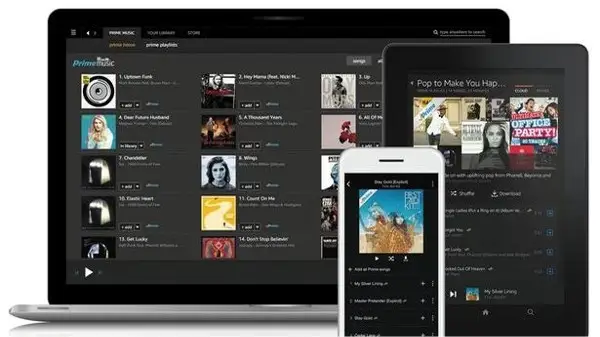
Amazon is slowly taking over the world, and it's a bit terrifying.
Luckily, the almighty Jeff Bezos bestowed upon us Amazon Music Unlimited, which is another lossless streaming option for hi-fi music lovers. To get access to CD-quality audio, however, you have to opt-in for Amazon's add-on option, Amazon Music HD.
You'll start to see a pattern here, as Amazon Music HD also offers two tiers of lossless streaming quality:
- Standard HD: Provides 24-bit/48kHz lossless CD quality audio
- Ultra HD: Provides lossless studio-quality audio up to 24-bit/192kHz, which is superior to CD-quality sound
The platform is similar to Tidal in that it also offers a range of exclusive video, podcast, and live event content. Plus, they included a built-in "Auto Mode" feature, which automatically switches between the HD and Ultra HD audio quality depending on the quality of your internet connection.
Final Thoughts - The Future of Lossless
Though it might not seem like much, lossless streaming is revolutionary for streaming services and even better for audiophiles who are serious about the way in which they listen to music.
With the rise of lossless streaming services like Apple Music, Tidal, and Amazon Music HD, it's easier than ever to enjoy high-fidelity music (so long, sweet MP3s).
Of course, while lossless streaming may require compatible hardware and higher bandwidth, the benefits of the improved lossless audio quality might be worth the small investment if you're a true music lover. We don't imagine you would have made it here if you weren't!
Download a lossless streaming service today and start enjoying music as it was meant to be heard!


